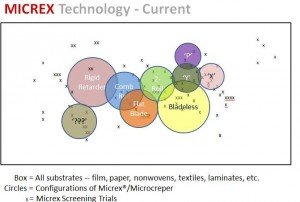How We Work:
The Micrex Process has a minimum of 27 different points of adjustment. Each of these “points” has from two to almost infinite levels of adjustment, allowing for potentially millions of different sets of process settings. In addition to these machine settings, the recipe of the incoming material is critical to the performance of the process.
 As there is no reliable predictive model for how a particular substrate will process on a Micrex/Microcreper, Micrex technology is applied using an empirical model based on trials. We have three lab scale machines in our production facility, on which we can produce all nine configurations of Micrex/Microcreper. This allows us to efficiently test your product under a wide range of conditions to quickly arrive at a go/no go gate toward further development.
As there is no reliable predictive model for how a particular substrate will process on a Micrex/Microcreper, Micrex technology is applied using an empirical model based on trials. We have three lab scale machines in our production facility, on which we can produce all nine configurations of Micrex/Microcreper. This allows us to efficiently test your product under a wide range of conditions to quickly arrive at a go/no go gate toward further development.
Based on the success of these initial “screening trials” for your product, we can seamlessly move through developmental and then production trials. Our extensive know-how allows us to optimize the final product to fit with your objectives.
Very often we are able to suggest modifications to the base substrate to not only improve performance on the Micrex/Microcreper, but also to yield system-wide lower costs.
A close working relationship with our customers is critical to success. Successful firms have learned that even when one round of product development has been completed, the key to continued success is to integrate Micrex in subsequent generations of products.
Almost without exception — no company has been able to successfully innovate new Microcreped products on their own production equipment.
New Technology:

Micrex technology is always evolving: by inventing new configurations of Micrex/Microcreper, or by expanding the operating envelope of an existing configuration, we are committed to expanding the usefulness of Micrex technology.

Screening trials: even unsuccessful ones help guide our research work. Back in 1988 we worked with only two versions of the Micrex/Microcreper; now we have nine.
